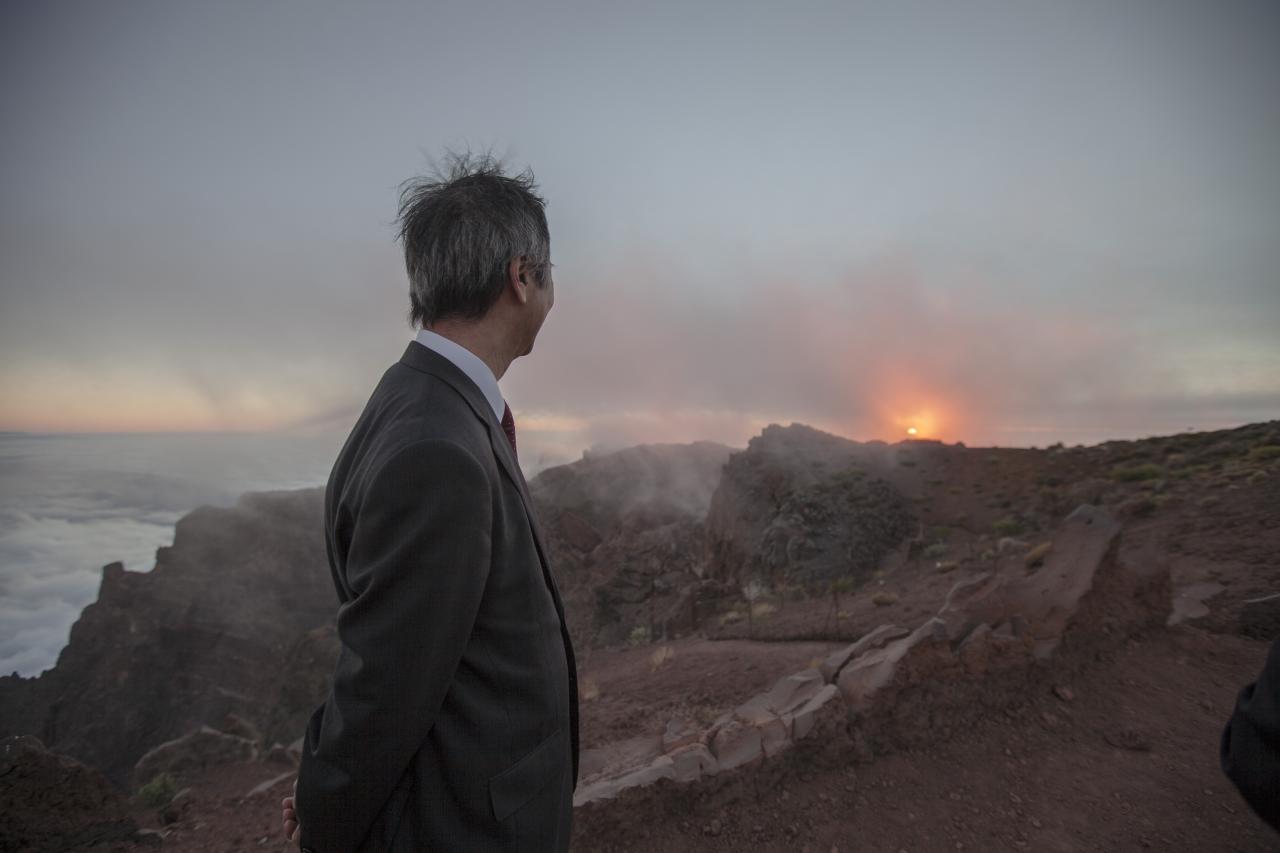We wondered if a newly awarded Nobel Laureate would have other obligations… But he did come, and obviously his presence brought many journalists to the Roque, to whom he kindly gave an informal press conference (see multimedia).
The next day he visited the Gran Telescopio CANARIAS (GTC), which he considered impressive. Later on, we talked about his research, the Nobel Prize, the CTA (Cherenkov Telescope Array)…
We also had some laughs together. Who said that scientists have no sense of humour?
Could you explain to us why you were awarded the Nobel Prize?
I had been working in Kamiokande and Superkamiokande and studied neutrinos, especially neutrinos produced by cosmic rays interaction in the atmosphere. Through this study we discovered that neutrinos oscillate, that means neutrinos have small masses.
Imagine you are talking to somebody who doesn’t know any astrophysics. How would you explain this?
A difficult question… There are small particles called neutrinos. They have no electric charge and therefore they can easily penetrate through the Earth. That means that they are very difficult to observe. Therefore at first we didn’t know much about the properties of the neutrinos, but we were lucky, we had a big detector called Superkamiokande and observed these neutrinos. We found that these neutrinos have very tiny masses.
As you have said, you have been directly involved in two huge experiments: Kamiokande and Superkamiokande in order to better understand the neutrinos’ behaviour. Many people wonder whether this kind of investment is justified, especially when compared to more day-to-day needs. How would you win them over?
Science is the work of the global community to enlarge our knowledge about nature. Some of the knowledge may not be directly related to our daily life, but eventually, let’s say one hundred years from now, it could well be related to our daily life. So I think pure science is worth doing.
From the scientific point of view, could you explain to us the relevance of the discovery you and Arthur B. McDonald made?
Neutrinos are one of the elementary particles. In the elementary particles community, there has been a theory of the standard model, which explains almost all experimental data. However, the standard model assumes that neutrinos have no mass. We now know that neutrinos do have mass and therefore the standard model needs to be modified or embedded in a still larger more fundamental theory of elementary particles. Therefore I think we gave the hint towards a better or deeper understanding of elementary particles.
Do you think it could be considered a kind of revolution into the model?
I would say we suggested that we have to start thinking about the physics beyond the standard model.
Could you say something about the importance of the Very High Energy Gamma Rays current and future research since you are the director of an important institute that works in this field?
Cosmic rays were first observed more than one hundred years ago. However we cannot fully understand where these cosmic rays are generated and how these cosmic rays are accelerated. One of the ways to answer these questions is to observe gamma rays. So every cosmic rays physicist is waiting for data from the CTA.
Can LST be considered the first step into this path?
Yes, especially LST must be very important, this telescope is so huge and therefore they can measure very faint flashes of Cherenkov light produced by electromagnetic showers, produced by gamma rays. LST is able to measure even “lower energy high energy gamma rays” and to open, let’s say, a new window that has not been studied extensively.
Have you any idea of what kind of discoveries we may expect with the LST? Maybe it’s too much to ask…
Since the sensitivity is ten times better than present generation experiments, we should have lots of discoveries. But I don’t know what would be the most important discoveries from this new instrument.
As far as I know state of the art technology is required in this new scientific window of the electromagnetic spectrum. Could you tell us something on the breaking characteristics of these new facilities, technologically speaking?
I don’t know in detail, I am not involved in CTA directly.
We won’t tell, if you don’t want us to.
(Laughs)
You’ve been awarded the best known prize in the world. Could you comment on your approach to these highly recognised awards?
The people’s reaction was much more than I expected. Soon after the announcement I started to get tons of emails. It only suggests that people recognize that these prizes to be extremely important.
They do. Do you think that’s going to change something for you?
For me, certainly it seems that my time is constantly stolen just for something. (Laughs)
And that you’re going to meet lots of journalists.
Yes, right! Even here! (Laughs)
Last but not least, what does this prize mean for astrophysics?
Our research is based on neutrinos, both me and Arthur McDonald observed neutrinos. In my case, in cosmic ray interactions; in his case, from the sun. We are essentially part of the astrophysics community, so I believe this should be a big boost towards more and more research in astrophysics.
Thank you very much.
Thank you very much for your hospitality.
Annia Domènech
Press conference - Takaaki Kajita
9th october 2015
More information:
Laying the first stone of the prototype of the LST (Large Size Telescope)
